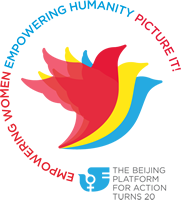Experts in gender, labor, and inclusive development gathered Tuesday at Nathan Associates to assess women’s economic progress in the 20 years since the Beijing Declaration and Platform for Action was hammered out in 1995. Moderator Louise Williams, a Principal Associate in Nathan’s international trade practice, asked three panelists to share their views on what has gone right, what hasn’t, and how data shapes the business and moral case for improving women’s economic status.
THE BRIGHT SPOTS
Steady reform in the United States has left few legal or policy-imposed limits and women’s economic progress is considered normal, according to Ariane Hegewisch, study director at the Institute for Women’s Policy Research, a U.S. think tank.
In other countries “there are bright spots, but too few,” said Dr. Bama Athreya, senior specialist in labor and employment rights at USAID. Significant declines in human trafficking and child labor, in particular a 40 percent decline in girl labor, signal broad commitment to improving labor conditions that greatly affect women in all countries.
Tazeen Hasan, a private sector development specialist at Women, Business, and the Law, World Bank, said that women’s economic status has improved with the reform of half the laws governing property rights since 1960. More women than ever before can get passports and other state-issued identification, pass on citizenship to their children, and claim head of household legal status. One observation of long-term studies is that legal reform is more likely and occurs more quickly when women hold political power.
THE SHADOWS
Still, of 173 countries recently surveyed, 90 percent still had at least one discriminatory law on the books, noted Ms. Hasan. In the Democratic Republic of the Congo, for example, married women cannot open a bank account, get a loan, or register a company without their husband’s permission.
Meanwhile, stagnation characterizes progress in labor markets. Ms. Hegewisch said that in the United States the wage gap and women’s labor force participation rates have changed little in 20 years—the main sticking point being a lack of work-family support systems. In developing countries, opportunities for formal employment are about the same as they were 20 years ago, said Dr. Athreya, with little being done to formalize off-the-books work done by women. One exception is the loosening of occupational segregation by gender in Latin America—and panelists agreed that granular observation of regional and national differences can reveal as much good news as bad.
DATA SHED LIGHT
Under pressure to be cost-effective, the U.S. policy environment is driven by data and microanalysis. But data collection and analysis is spotty to nonexistent at the national level in most developing countries even though data make the business and the moral case for empowering women. Ms. Hasan cited a study showing that when Ethiopia stopped requiring women to have their husbands’ permission in various economic transactions, women’s labor force participation rates increased as did sector productivity. After India reformed land inheritance laws, impact data showed a nearly immediate increase in investment in girls’ education and delayed age of marriage followed later by an increase in women’s access to bank accounts and overall improvement in household sanitation.
The brightest spot? Opportunities and proven means for advancing women’s economic empowerment abound: paid paternity and parental leave; international conventions that induce national reforms, particularly of domestic violence laws; data-driven experiments in closing the wage gap, like the Boston Women’s Compact; reform of commercial codes; and the growing involvement of men as champions of women’s economic progress.
Tuesday’s event was organized by the Gender and Inclusive Development Working Group of the Society for International Development (SID) and hosted by Nathan Associates and SID’s Development Finance Workgroup. The GID working group has organized an event for each of the Beijing Declaration’s 12 points of concern. Today’s event was the eleventh. Next month’s panel discussion will focus on progress on health and gender. The final event in December will cover gender and the media.
This blog post was originally published by Nathan Associates, Inc. http://www.nathaninc.com/news/women%E2%80%99s-economic-progress-20-years-beijing-has-bright-spots-shadows
Learn more about the yearlong series: Beijing+20: What Does Meaningful Progress Look Like?:  http://www.sidw.org/2015-sid-gid-discussion-series
http://www.sidw.org/2015-sid-gid-discussion-series
Join us on Twitter: #SIDwGID and #Voices4Equality

